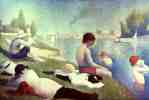![]()
 Une Baignade, Asnières
Une Baignade, Asnières
1883-84 (retouched 1887); "Bathing at Asnières"; 79 x 118 1/2 in; Signed, bottom left; National Gallery, London
Painted in the same year as Pissarro's The Pork Butcher, Seurat's first large picture shows in contrast the monumental sense of form which complemented the method (still in process of development) of dividing color. This was a move away from Impressionism though there is an Impressionist atmosphere in the landscape background with the river distance, the Courbevoie bridge and the smoking factory chimneys of the industrial Paris suburb of Asnières. In Impressionist fashion also he made a number of small oil sketches from which the final composition was derived. The sketches have the character that belongs to work carried out on the spot.
Asnières was to Seurat and his friend Signac what Argenteuil had been to Monet and Renoir. The Seine and its boats offered a like attraction; the bridge at Courbevoie and the island of the Grande Jatte, seen across the river from the bathing-place on the right, were also to furnish material for magnificent pictures. Une Baignade is a whole collection of Seurat's motifs---and a truly remarkable work for a young man of twenty-four. The kinship with Piero della Francesca that has often been remarked is distinct in the ordered rhythm of design and the firmly simplified contours. The feeling of repose is heightened by the lateral directions of figures, stylized shadows and river bank.
The picture was exhibited at the first Salon des Indépendants in 1884 and in 1886 was one of the `Works in Oil and Pastel by the Impressionists of Paris' exhibited by Durand-Ruel at the National Academy of Design in New York. Too original to find immediate favor either in Paris or New York, it received harsh criticism. The critic in an American paper who described Une Baignade as the product of `a vulgar, coarse and commonplace mind' seems with every epithet to present the exact opposite opinion to that with which the work is regarded now.
Planning the composition of Bathing at Asnieres, Seurat made field trips to the island of La Grande Jatte; the approximate site can be checked on any map of the Paris suburbs. But this first of his big canvases was executed in the studio, merely drawing upon the preliminary studies made outdoors.
Coming from Paris,
Beaubourg wrote to Coquiot, the island was on one's right, more
or less opposite the spot where people swim on Sundays, halfway between the
Bineau bridge and the northern tip of the island, just where the river makes
a sharp bend toward Courbevoie and Asnieres. Seurat was often to be seen
painting there.
Jules Christophe left this short description of Bathing at
Asnieres:
Water, air, the railroad bridge in the distance, boats, shimmering
trees, seven men and boys in various stages of undress, either in the water or
sprawled upon the grass. Not many people saw the canvas (at the Salon des
Independants it was relegated to the bar), but it represented a great deal of
work.
According to Signac this large composition, for which Seurat had made
so many preliminary drawings and oil studies, was painted in broad, smooth
brush strokes placed atop one another, in a palette of ochres and more vivid
colors. Like
Delacroix,
he blended his colors in individual areas.
Signac
goes on to sum up Seurat's method as follows: Observance of the laws of
contrast, methodical separation of the elements (light, shadow, local color,
reactions).
This is a hazy work, saturated with summer heat. In the
distance loom factories and their smokestacks. We feel the oppressiveness of
the atmosphere, the immobility of the scene. The light here weighs more
heavily than the shadows. In an article, Arsene Alexandre refers to the
enormous amount of work that went into this painting: Bathing at Asnieres
made it clear that Seurat was the one younger artist capable of putting his
back into it-one of the few capable of organizing a vast composition
utilizing hitherto unknown techniques.
The many partial studies that went to produce this work have been brought together into a coherent, unified whole. The summer silence is broken only by the boy who is cupping his hands to make a sound like a boat horn. This is vacation time, rest after toil. The distribution of blacks and whites, light tones and dark, strait and curving lines (the latter predominating) is very elaborate. The light, the sun, the greenery, the buildings, the water, the people, the boats gliding along in the background- everything gives off the torpid heat of a summer afternoon.